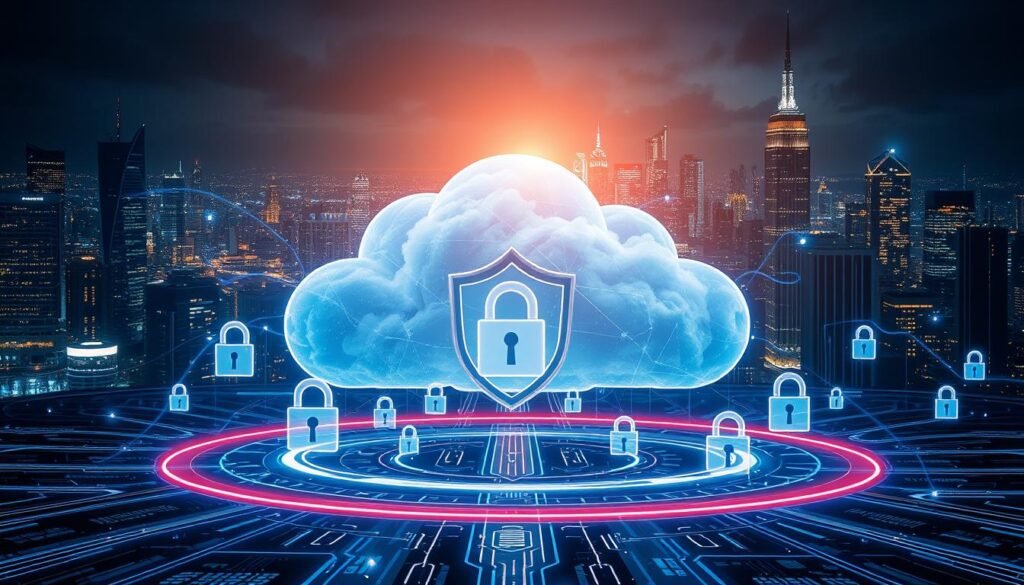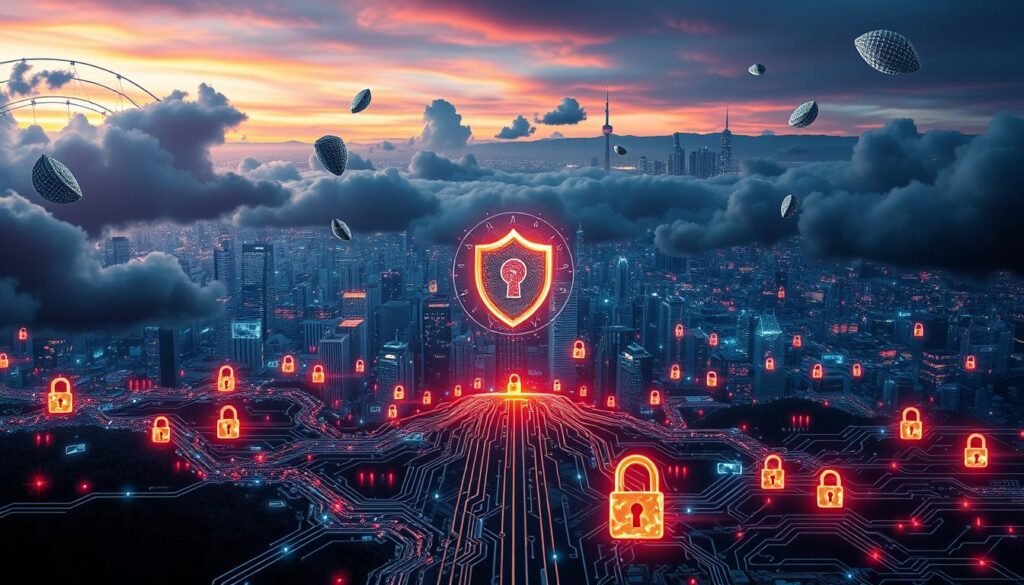As we enter the new year, cybersecurity threats are changing fast. They pose big challenges for businesses of all sizes. Data breaches and cybercriminal tactics keep evolving, making it crucial for organizations to stay alert and act fast to protect their digital assets.
In 2024, the threat landscape will get even more complex. New cyber threats will target weak spots in your organization’s systems. These could include AI-powered attacks, ransomware, and phishing scams. These risks are always there, and the damage they can cause is severe.
If you’re a business leader, you know how vital it is to protect your organization from these threats. With so many risks out there, it’s hard to know where to begin. That’s why this guide is here to help you understand the complex world of cybersecurity. It will show you how to spot the key risks that could affect your organization in the coming year.
Key Takeaways
- Understand the top cybersecurity threats that organizations will face in 2024, including data breaches, ransomware, phishing scams, and IoT vulnerabilities.
- Explore the evolving tactics of cybercriminals and how they are adapting to new technologies and security measures.
- Learn about the persistent danger of data breaches and the steps you can take to mitigate the risk.
- Discover the rising tide of ransomware attacks and the strategies for protecting your organization.
- Gain insights into the sophisticated phishing techniques that are exploiting human vulnerabilities.
Top Cybersecurity Threats in 2024
As the digital world grows, businesses must watch out for new cybersecurity dangers. In 2024, companies will face many new cyber threats and tactics from hackers. It’s key to know these risks to protect your data and systems.
Emerging Cyber Threats for Businesses
IoT vulnerabilities are a big threat in 2024. More devices connect to the internet, giving hackers more ways to attack. Unsecured IoT devices can lead to data breaches and malware.
Cloud security breaches are also on the rise. More companies move to the cloud, making strong cloud security vital. Hackers aim to find weak spots in cloud systems, risking data and apps.
Evolving Tactics of Cybercriminals
Hackers keep finding new ways to trick people. Phishing scams get smarter, trying to steal info or spread malware. Ransomware attacks also get more advanced, using AI-powered attacks and zero-day exploits.
To fight these threats, companies need to invest in cybersecurity services, network security solutions, and cybersecurity consulting. This ensures strong defense against cyber dangers.
Data Breaches: A Persistent Danger
Data breaches are a big problem in today’s world. They can hurt any business, big or small. A breach can lose you important data, damage your reputation, and cost a lot of money.
Getting help from a cybersecurity consulting service is key. They can do security vulnerability assessments to find and fix problems. They also offer cyber threat intelligence and managed security services to keep your data safe.
It’s important to have a strong plan for cybersecurity compliance and risk management in cybersecurity. This includes firewall protection services and cloud security services. A good strategy can protect your business from data breaches.
Staying ahead of cyber threats is crucial. Regular cybersecurity audits and incident response services can help. Working with data protection services and information security management experts can keep your business safe.
| Cybersecurity Measure | Description |
|---|---|
| Security Vulnerability Assessment | Identifies and evaluates potential weaknesses in your organization’s cybersecurity defenses, allowing for targeted improvements. |
| Managed Security Services | Provides comprehensive monitoring, detection, and response capabilities to safeguard your network and systems from cyber threats. |
| Cybersecurity Audit | Examine your organization’s cybersecurity posture, policies, and procedures to ensure compliance and identify areas for enhancement. |
“The only way to ensure the security of your organization is to stay vigilant and proactive in your cybersecurity efforts.”
The Rising Tide of Ransomware Attacks
Ransomware is a big problem in the world of cybersecurity. It’s getting smarter, with hackers finding new ways to steal and hold data for ransom. Companies need to stay on top of protecting their digital stuff.
Ransomware’s Evolving Tactics
Ransomware has changed a lot. Now, hackers steal data first and then encrypt it. They threaten to share the stolen data if they don’t get paid. This makes it even more important for businesses to have strong security measures.
Protecting Against Ransomware
Stopping ransomware attacks takes a lot of work. It involves checking for weaknesses, staying informed about threats, and being ready to respond. Companies should also do regular security checks and have plans to deal with risks.
Teaching employees about cybersecurity is key. They need to know how to spot and handle ransomware. By keeping their networks and cloud services secure, companies can fight off more ransomware attacks in 2024 and later.
Phishing Scams: Exploiting Human Vulnerabilities
Phishing scams are a big problem in cybersecurity. They trick people into giving out personal info or letting hackers into systems. These scams are getting better at fooling people, using our weaknesses against us.
Sophisticated Phishing Techniques
Cybercriminals are getting smarter. They use many tricks to catch people off guard. From spear-phishing to social engineering, their methods are hard to spot.
- Impersonation: They pretend to be from places you trust, like banks or IT security company reps.
- Fake Websites: They make fake sites that look real, trying to get you to give up your login info.
- Leveraging Current Events: They use big news or trends to make their messages seem urgent and important.
To fight these scams, companies need strong cybersecurity services and network security solutions. They should do security vulnerability assessment, cyber threat intelligence, and managed security services. Teaching employees how to avoid scams and keeping everyone alert is key to stopping cyber attacks in 2024 and later.
“Phishing attacks are the most common type of cybersecurity threat, costing businesses billions each year. Staying informed and implementing robust security measures is essential for safeguarding your organization.”
IoT Vulnerabilities: Securing the Connected World
The Internet of Things (IoT) is changing our lives fast. It’s making our world more connected, from smart homes to industrial systems. But this growth has also made our world more vulnerable to cyber threats.
Cybercriminals are taking advantage of these weaknesses. They’re targeting businesses and individuals with attacks. It’s a big problem that needs a big solution.
To tackle this, we need a strong plan. We must focus on network security, check for vulnerabilities, and gather threat intelligence. This will help protect IoT devices from harm.
As IoT devices connect to the cloud, security becomes even more critical. We need to do regular audits and manage risks well. This ensures our data and systems stay safe.
Keeping our devices and data secure is a big challenge. We must stay ahead of threats. A good strategy includes using firewalls, monitoring networks, and managing mobile devices carefully. This will help protect us from future cyber threats.
| IoT Vulnerability | Potential Impact | Mitigation Strategies |
|---|---|---|
| Weak default passwords | Unauthorized access, data breaches | Implement strong password policies and enable two-factor authentication |
| Unpatched software vulnerabilities | Exploit by cybercriminals, system compromises | Regularly update IoT devices with the latest security patches |
| Insecure communication protocols | Eavesdropping, man-in-the-middle attacks | Use encryption and secure communication protocols |
| Lack of device authentication | Unauthorized access, data manipulation | Implement robust authentication mechanisms for IoT devices |
“The proliferation of IoT devices has created a vast attack surface, and organizations must prioritize comprehensive security measures to safeguard their connected ecosystems.”
Cloud Security Risks: Mitigating Threats
In today’s cloud computing world, companies face many cloud security risks. They need to stay alert and act fast. More businesses are using cloud-based cybersecurity services and IT security company solutions. So, protecting these virtual spaces is more important than ever.
Cloud Security Best Practices
To keep your data and systems safe in the cloud, follow these network security solutions and cybersecurity consulting tips:
- Do regular security vulnerability assessments to find and fix weak spots.
- Use strong data protection services and cyber threat intelligence to prevent data leaks.
- Use managed security services and cloud security services to improve your cybersecurity audit and risk management in cybersecurity.
- Make sure you have information security management and identity and access management rules to control cloud access.
- Keep up with cybersecurity compliance by doing regular checks and updates.
- Set up firewall protection services and network security monitoring tools to catch and handle threats.
By tackling cloud security risks early, companies can face the cybersecurity 2024 future with confidence. They can protect their important assets.

“Securing the cloud is a crucial priority for businesses in 2024 and beyond. Adopting comprehensive cloud security strategies is essential for mitigating emerging threats and protecting critical data.”
AI-Powered Attacks: The Next Frontier
Cybersecurity experts must watch out for AI-powered attacks as the digital world changes. These threats use artificial intelligence and machine learning. They make cyber attacks more powerful, posing big challenges for the security company and their clients.
Cybercriminals use AI to make network security solutions better and to do big security vulnerability assessment jobs. These attacks can find and use weaknesses fast. They also get better at avoiding cyber threat intelligence and managed security services.
Companies need to focus on cybersecurity audit and risk management in cybersecurity to fight these threats. They must also work on information security management and cybersecurity compliance. It’s important to invest in network security monitoring and cybersecurity training programs. This helps employees know how to handle cyber risk assessment and cyber attack prevention.
As we move into cybersecurity 2024, it’s key for businesses to stay informed and active. This helps them deal with the dangers of ai-powered attacks.
“The rise of AI-powered cyber threats is a game-changer, and organizations must adapt their cybersecurity services to stay one step ahead of cybercriminals.”
Zero-Day Exploits: Staying Ahead of the Curve
Zero-day exploits are a big challenge in cybersecurity. Hackers may exploit these undiscovered flaws before they are fixed. This leaves companies open to serious attacks. It’s key for businesses to act fast and have strong plans to handle these threats.
Responding to Zero-Day Vulnerabilities
Dealing with zero-day exploits needs a mix of services and knowledge. Here are some steps to lessen the damage:
- Do a thorough security check to find weak spots in your systems and software.
- Use cyber threat intelligence to keep up with new zero-day exploits and adjust your security.
- Get managed security services for constant monitoring and quick response to threats.
- Do regular cybersecurity audits to make sure your security practices are current.
- Follow strict cybersecurity compliance to meet industry standards.
By tackling zero-day vulnerabilities early and improving your network security, you can lower the risk of attacks. This helps protect your company from the harm caused by these threats.
To stay ahead in cybersecurity, you need the latest tech, expert training, and a deep understanding of risk and prevention. Investing in these areas helps your company face the changing cybersecurity landscape in 2024 and beyond.
Insider Threats: Mitigating the Risk
In the world of cybersecurity, insider threats are a big worry for companies. These threats can come from unhappy employees, careless insiders, or hacked accounts. They can really hurt your business. As we get closer to 2024, it’s key to know how to fight these threats and keep your important stuff safe.
To tackle insider threats, using strong identity and access management (IAM) is crucial. This helps control who gets to sensitive data and systems. It lowers the chance of unauthorized access and insider breaches. Also, doing regular security vulnerability assessments and cybersecurity audits finds and fixes weak spots. This makes sure your network security solutions and endpoint security solutions are strong.
Good risk management in cybersecurity is also key. Doing detailed cyber risk assessments and using solid information security management plans helps spot and stop threats early. Cybersecurity consulting and managed security services offer the know-how and tools to handle the complex world of cybersecurity 2024.
Also, investing in cybersecurity training programs makes your team more alert to insider threats. Teaching your team about data protection services, cyber threat intelligence, and network security monitoring helps them protect your business.
Stopping insider threats is a big challenge, but with the right steps, you can lower the risk and protect your assets. Working with an it security company and cybersecurity services helps your business stay safe in the changing world of cybersecurity compliance and cyber attack prevention.
“The greatest threat to an organization’s security often comes from within. Effective insider threat mitigation requires a comprehensive and proactive approach.”
Supply Chain Attacks: Securing the Supply Network
In today’s world, supply chain attacks are a big threat to many businesses. These attacks target the network of vendors and partners that companies rely on. They can lead to data breaches, system disruptions, and financial losses. As companies outsource more, protecting the supply chain is crucial for IT security companies and cybersecurity consulting firms.
Supply Chain Risk Management Strategies
To combat supply chain attacks, companies need a proactive approach to cybersecurity risk management. A strong supply chain risk management strategy is essential, and it should focus on a few key areas:
1. Vendor Vetting and Assessment
Evaluating the security of vendors, partners, and service providers is crucial. Ensure they comply with your cybersecurity standards and have robust measures in place to protect your data and systems.
2. Continuous Monitoring and Visibility
Implement network security monitoring across your supply chain to maintain visibility. This allows you to quickly detect and address cyber threats and vulnerabilities before they escalate.
3. Incident Response and Contingency Planning
Establish incident response and contingency plans to minimize the impact of a potential supply chain attack. These plans help ensure business continuity and protect critical assets, even in the face of disruptions.
4. Third-Party Risk Assessments
Regularly conduct cyber risk assessments and security audits of third-party vendors. This process helps you identify and address vulnerabilities within your supply chain, enabling informed decisions that reduce the risk of cyber attacks.
By using these supply chain risk management strategies, companies can improve their cybersecurity posture. This helps them fight off the threat of supply chain attacks better.
| Strategy | Description | Benefits |
|---|---|---|
| Vendor Vetting and Assessment | Thoroughly evaluate the security practices and capabilities of vendors, partners, and service providers. | Ensures vendors meet security standards and can effectively safeguard sensitive data and systems. |
| Continuous Monitoring and Visibility | Implement solutions to maintain real-time visibility into the supply chain ecosystem and detect potential threats. | Enables timely detection and response to security vulnerabilities and cyber threats. |
| Incident Response and Contingency Planning | Develop comprehensive plans to manage and mitigate the impact of a supply chain attack. | Ensures business continuity and protects critical assets in the event of a security incident. |
| Third-Party Risk Assessments | Regularly conduct cyber risk assessments and security audits to identify and address vulnerabilities. | Empowers organizations to make informed decisions and implement effective cyber attack prevention measures. |
By using these supply chain risk management strategies, companies can improve their cybersecurity posture. This helps them fight off the threat of supply chain attacks better.
Cybersecurity Services: Protecting Your Business
Businesses must be careful and proactive to protect themselves from cyber threats. Cybersecurity services help keep your business safe from many dangers. They include security vulnerability assessments and managed security services to fight off cyber attacks.
Penetration testing is a key service. It pretends to be a real attack to find weak spots in your systems. This helps make your network security solutions stronger. Also, cybersecurity audits check if your security meets standards and laws.
Managed security services offer constant monitoring and help with threats. They include endpoint security solutions, cloud security services, and data protection services. These protect your important data.
Choosing a reliable IT security company for cybersecurity services gives you access to cyber threat intelligence and risk management advice. This helps you stay safe from new cybersecurity threats and make smart choices for your business.
Looking to improve your identity and access management, get firewall protection services, or get better malware protection solutions? A full cybersecurity services plan is essential for protecting your business in 2024 and later.
Risk Management in Cybersecurity
In today’s fast-changing digital world, risk management in cybersecurity is key for all businesses. As cyber threats grow more common and complex, having a solid risk management framework is crucial. It helps protect your business from cyber attacks.
Implementing a Risk Management Framework
Starting with a structured plan is the first step in risk management in cybersecurity. This plan should include several important steps:
- Risk Identification: Find the possible cyber risks that could harm your business. This includes weak spots in your network security solutions, IT security company setup, and cybersecurity compliance.
- Risk Assessment: Look at how likely and how big of a problem each cyber risk could be. This helps you focus on fixing the biggest problems first.
- Risk Mitigation: Use cybersecurity services like security vulnerability assessments and managed security services to lower the risks. This helps keep your business safe from cyber attacks.
- Continuous Monitoring and Improvement: Keep checking and updating your risk management in cybersecurity plans. This ensures your information security management stays strong as cybersecurity 2024 changes.
By taking a proactive and detailed approach to risk management in cybersecurity, businesses can better fight cyber threats. This helps keep their operations, data, and reputation safe.

Identity and Access Management: Controlling Access
In today’s fast-changing world of cybersecurity, identity and access management (IAM) is key. It helps protect important systems and data. IAM is a vital part of cybersecurity services and network security solutions. This section will cover IAM’s main ideas and best practices, helping you keep your business safe from cyber threats.
User authentication is at the core of IAM. It checks who is trying to get into your systems. Using strong authentication, like multi-factor, helps stop unauthorized access and data breaches. Also, good authorization and access control make sure users only get what they need.
Good IAM also means managing user identities across different systems and devices. This includes mobile security management and endpoint security solutions. By managing identities in one place, businesses can easily give and take away access as needed.
It’s important to regularly check and audit your IAM setup. This means doing security vulnerability assessments to find weak spots. It also means following cybersecurity compliance rules and keeping up with new cybersecurity 2024 threats.
By following identity and access management best practices, security companies help their clients stay safe in the complex world of cybersecurity. By controlling who gets in and keeping user identities safe, businesses can lower the risk of unauthorized access, data breaches, and other cybersecurity threats.
| IAM Best Practices | Benefits |
|---|---|
| Multi-factor authentication | Enhances security by requiring multiple forms of verification |
| Role-based access control | Ensures users have the appropriate level of privileges |
| Centralized identity management | Streamlines user provisioning and de-provisioning |
| Regular security audits | Identifies and addresses vulnerabilities in the IAM system |
“Effective identity and access management is the foundation for a robust cybersecurity strategy in the digital age.”
Cybersecurity Compliance: Meeting Regulatory Requirements
In today’s fast-changing digital world, keeping up with cybersecurity rules is key for businesses. They must follow the latest standards to avoid legal and financial problems. For cybersecurity services, security companies, and network security solutions providers, staying current is vital.
Compliance Frameworks and Standards
A strong cybersecurity compliance plan needs to know the various rules and standards. The NIST Cybersecurity Framework, ISO 27001, and GDPR are some of the most important. These guides help with cybersecurity consulting, security vulnerability assessments, and managed security services.
Keeping up with new rules and specific industry needs is crucial. This helps with cybersecurity audits and information security management. By focusing on GDPR compliance services and other rules, companies can avoid big fines and damage to their reputation in the cybersecurity 2024 world.
- Know the main compliance frameworks and standards for your field
- Do regular cybersecurity audits to find and fix gaps
- Use strong data protection services and cyber threat intelligence steps
- Make sure your network security solutions and managed security services meet the rules
- Keep up with new cybersecurity compliance trends and rule changes
By taking a proactive and detailed approach to cybersecurity compliance, companies can protect their work, data, and customer trust. This is important in the changing cybersecurity world of 2024.
Conclusion
The cybersecurity world in 2024 is full of dangers for organizations. Data breaches and ransomware attacks are big threats. Also, IoT vulnerabilities and cloud computing risks are important to watch out for.
AI attacks and zero-day exploits make security strategies even more crucial. Insider threats and supply chain attacks add more complexity. This means organizations need a strong, multi-faceted approach to managing risks.
To fight these top cybersecurity threats in 2024, companies should invest in top-notch cybersecurity services. They need to use network security solutions and do security vulnerability assessments. They should also use data protection services, cyber threat intelligence, and managed security services.
By adopting a zero-trust security model and focusing on identity and access management, companies can control access to sensitive data. This reduces the risk of cyberattacks and data breaches.
The best way to deal with the complex cybersecurity world in 2024 is to be proactive and keep evolving. By staying ahead and following cybersecurity compliance rules, businesses can protect themselves from many threats in the coming year.



